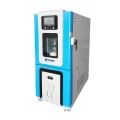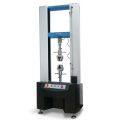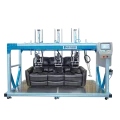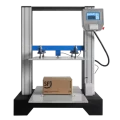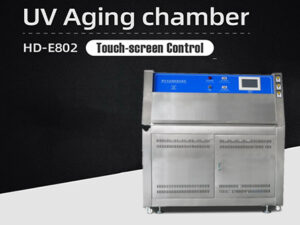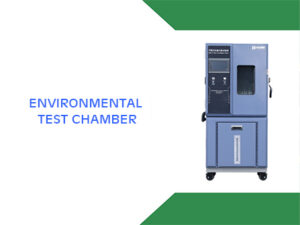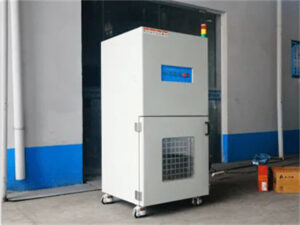Aging testing is a laboratory process that determines how quickly a material degrades, allowing for the prediction of its lifespan. It can mimic the harm done by UV rays, ozone, and temperature. Aging test chambers can quickly mimic the damage that would typically take months or years to occur outside.
In today’s world, the quality of materials and products is of utmost importance. The use of UV Accelerated Aging Chamber has become an essential tool in assessing the durability and longevity of products, especially in industries such as automotive, aerospace, and construction. These test chambers simulate the effects of UV radiation on materials, providing vital information on how products will age in real-world conditions.
What is an UV Aging Test Chamber?
An UV aging test chamber is a device that is used to test the effects of UV radiation on materials. The chamber is designed to simulate the UV radiation that occurs naturally from the sun. The test chamber exposes materials to UV radiation at specific wavelengths and intensities to simulate the effects of prolonged exposure to sunlight. The materials are placed in the chamber and exposed to UV radiation for a specific period of time, and the effects on the materials are observed and measured.
UV Aging Test Chamber (HD-E802 Leaning Tower )
Benefits of UV Aging Test Chamber
The use of an UV aging test chamber provides numerous benefits to manufacturers and researchers, including:
Predicting product lifespan: By simulating the effects of prolonged exposure to UV radiation, manufacturers can predict how their products will age and how long they will last in real-world conditions.
Identifying potential problems: The use of UV aging test chambers can help manufacturers identify potential problems with their products before they are released to the market. By detecting these problems early, manufacturers can make necessary changes and improvements to their products.
Compliance with regulations: Many industries, such as automotive and aerospace, are required to comply with specific regulations and standards. The use of UV aging test chambers can help manufacturers ensure that their products meet these requirements.
Improved product quality: By testing the effects of UV radiation on materials, manufacturers can identify the best materials and coatings to use to improve the quality and durability of their products.
Common Problems with UV Aging Test Chambers
While the use of UV aging test chambers provides numerous benefits, there are also common problems that manufacturers and researchers may encounter, including:
Calibration issues: UV aging test chambers need to be calibrated regularly to ensure that the radiation intensity and wavelength are consistent. Failure to calibrate the chamber can result in inaccurate test results.
Contamination: Dust and other particles can accumulate on the materials being tested, affecting the test results. The chamber needs to be cleaned regularly to prevent contamination.
Temperature control: The temperature inside the chamber needs to be controlled carefully to ensure that it remains consistent throughout the test. Any fluctuations in temperature can affect the test results.
UV lamp lifespan: The UV lamps used in the test chamber have a limited lifespan and need to be replaced regularly. Failure to replace the lamps can result in inaccurate test results.
In addition to the common problems mentioned above, there are a few other factors to consider when using an UV aging test chamber. These factors include the type of materials being tested, the wavelength and intensity of the UV radiation used, and the duration of the test.
Type of Materials Being Tested
Different materials react differently to UV radiation. Some materials may be more resistant to UV radiation than others. Therefore, it is important to consider the type of material being tested when selecting a UV aging test chamber. For example, if you are testing the durability of plastic materials, you may need a test chamber that uses a specific type of UV radiation to simulate the effects of sunlight on plastic.
Wavelength and Intensity of the UV Radiation Used
The wavelength and intensity of the UV radiation used in the test chamber can also affect the test results. Different materials react differently to UV radiation at different wavelengths and intensities. Therefore, it is important to select the appropriate wavelength and intensity of UV radiation for the materials being tested. This can be done by referring to relevant standards and regulations.
Duration of the Test
The duration of the test also plays a significant role in determining the accuracy and reliability of the test results. The length of the test will depend on the intended use of the product and the expected lifespan. It is important to ensure that the duration of the test is sufficient to provide accurate and reliable test results.
What are some specifications of aging test chamber?
An aging test chamber is a specialized piece of equipment used to simulate the effects of time and environmental stress on various materials and products. Here are some common specifications of aging test chambers:
Temperature Range: Aging test chambers can typically operate within a temperature range of -70°C to 180°C, although some may have a narrower temperature range.
Humidity Range: Aging test chambers can simulate different levels of humidity ranging from 10% to 98%.
Chamber Size: Aging test chambers come in different sizes, ranging from small benchtop models to large walk-in chambers that can accommodate large products.
UV Light Exposure: Some aging test chambers are equipped with UV lamps to simulate the effects of natural sunlight on materials.
Airflow: Aging test chambers can be equipped with different types of airflow systems to simulate different environmental conditions, such as natural convection or forced convection.
Gas Supply: Aging test chambers may have the capability to control the concentration of specific gases within the chamber to simulate real-world conditions.
Test Cycle Programming: Aging test chambers may allow for the programming of specific test cycles, including the rate of temperature and humidity change over time.
Data Logging: Aging test chambers may be equipped with sensors to monitor temperature, humidity, gas concentration, and other parameters, with the capability to record and store data for later analysis.
In summary, UV aging test chambers are essential tools for assessing the durability and longevity of products. They provide valuable information on how materials will react to prolonged exposure to UV radiation, allowing manufacturers to predict product lifespan, identify potential problems, and improve product quality. However, to ensure the accuracy and reliability of test results, it is important to consider factors such as the type of materials being tested, the wavelength and intensity of the UV radiation used, and the duration of the test. By taking these factors into consideration and addressing common problems, manufacturers and researchers can use UV aging test chambers to develop high-quality and long-lasting products.


